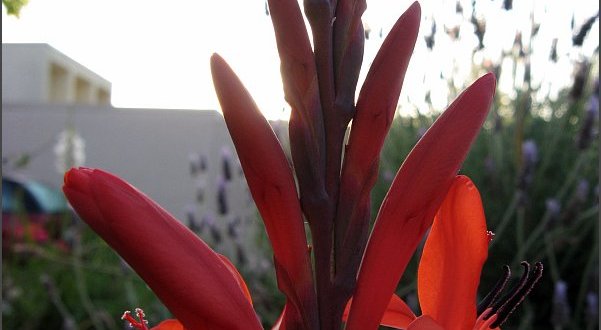Watsonia bulbs are an excellent example of how simple gardening can be when the right plant is matched to suitable growing conditions. Fresh watsonia bulbs are available from early September through mid November only. They naturalize so you can leave them in the soil for next year.
Outdoor Beds
Find a location where the soil drains well. If there are still water puddles 5-6 hours after a hard rain, scout out another site. Or amend the soil with the addition of organic material to raise the level 2-3 inches to improve the drainage. Peat moss, compost, ground bark or decomposed manure all work well and are widely available.
Site your watsonia where they will receive full sun.
Dig holes and plant the watsonia bulbs (corms, actually) 4″ deep and 4″-6″ apart. The corms look like fat, flat gladiola bulbs. There is a small point or even a bit of last year’s stem on the side that should be placed facing up.
After planting, water watsonia well to settle the soil around the bulbs. Roots and sprouts will form in the autumn. Winter will bring taller growth and flowers will develop in the spring.
When in bloom, feel free to cut watsonia flowers for bouquets. This will not hurt the plants.
After blooming has finished for the season leave the foliage in place; don’t cut it off. The leaves will gather sunlight, create food through photosynthesis and strengthen the bulb for the future. Water as needed during active growth periods; about 1″ of moisture per week is a good estimate.
At the end of the summer the leaves will yellow and die back as the plant slips into dormancy. Foliage may be removed at this point. Your watsonia will rest for a few months before beginning the next growing cycle.
Watsonia form sizeable clumps over time and eventually flowering will diminish. When this occurs, dig up the clump and separate it into a number of smaller plants. Distribute them around your garden or share your bounty with friends. Replant promptly.
Site your watsonia where they will receive full sun.
Dig holes and plant the watsonia bulbs (corms, actually) 4″ deep and 4″-6″ apart. The corms look like fat, flat gladiola bulbs. There is a small point or even a bit of last year’s stem on the side that should be placed facing up.
After planting, water watsonia well to settle the soil around the bulbs. Roots and sprouts will form in the autumn. Winter will bring taller growth and flowers will develop in the spring.
When in bloom, feel free to cut watsonia flowers for bouquets. This will not hurt the plants.
After blooming has finished for the season leave the foliage in place; don’t cut it off. The leaves will gather sunlight, create food through photosynthesis and strengthen the bulb for the future. Water as needed during active growth periods; about 1″ of moisture per week is a good estimate.
At the end of the summer the leaves will yellow and die back as the plant slips into dormancy. Foliage may be removed at this point. Your watsonia will rest for a few months before beginning the next growing cycle.
Watsonia form sizeable clumps over time and eventually flowering will diminish. When this occurs, dig up the clump and separate it into a number of smaller plants. Distribute them around your garden or share your bounty with friends. Replant promptly.
Pots, Barrels, Tubs & Urns
Fill your containers with good quality, well-drained soil. Almost any commercially available potting medium will work fine. Make sure there are adequate drainage holes; watsonia must never sit in waterlogged soil or they will rot.
Site your containers where they will receive full sun.
Plant your watsonia 4″ deep and 4″-5″ apart for the most brilliant display. The corms look like fat, flat gladiola bulbs with a small point or even a bit of last year’s stem on the side that should be placed facing up.
After planting, water your containers well to settle the soil around your bulbs. Roots will form in the fall. A few sprouts may also develop in autumn if you live in a warm region. Taller top growth and flower stems will form in the spring.
Enjoy your flowering containers, snipping a few flowers if you like. This won’t hurt your plants.
After blooming has finished for the season leave the foliage in place; don’t cut it off. The leaves will gather sunlight, create food through photosynthesis and strengthen the bulb for the future. Water as needed during active growth periods; about 1″ per week.
At the end of the summer the leaves will yellow and die back as the plant slips into dormancy. Foliage may be removed at this point. Your watsonia will rest for a few months before beginning the next growing cycle.
Watsonia will form sizeable clumps over time and eventually flowering will diminish. When this occurs, dig up the clump and separate it into a number of smaller plants. Distribute them around your garden or share with friends. Replant promptly.
Quantity tips:
For 12-15” pots – plant 10
For 10” pots – plant 7
For 8” pots – plant 5








